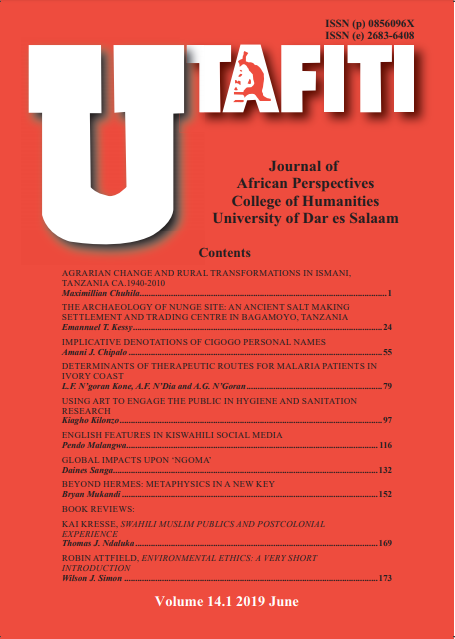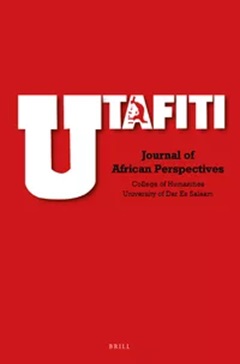THE ARCHAEOLOGY OF NUNGE SITE: AN ANCIENT SALT MAKING SETTLEMENT AND TRADING CENTRE IN BAGAMOYO, TANZANIA
Abstract
The Bagamoyo area is among the Tanzanian coastal locations where evidence of intercontinental trade dates back to the last few centuries of the first millennium AD. Previous investigations have indicated that the region ' s earliest settlement is represented by Early Triangular Incised Ware [TIW] around 600 to 700 AD, at Bwembweni site located two kilometres south of Kaole. During the Later TIW, the population shifted to Kaole Hill during the period noted by the use of Plain Ware, and later moved to the adjacent Kaole Ruins by the thirteenth century. Traditionally, the majority of earlier investigations for such conclusions have been restricted to Bwembweni and Kaole sites, and to a limited extent to Bagamoyo Town itself and its vicinity. However, recent reconnaissance and excavation of Nunge, a single type pottery tradition site located to the north, suggests that although Bagamoyo ' s involvement in intercontinental exchange dates back to the seventh century AD, the narrative is more complicated than previously assumed. It appears that between the subsequent ninth to eleventh centuries, the area lost such links, before resurfacing again in the twelfth to thirteenth centuries. Within that time frame, Nunge developed into an extensive urban centre whose prosperity was based on salt production for exchange. This discovery suggests that the development to urbanism at Bagamoyo predates that of the Kaole town, when the area is known to have had a few links with the outside world. These findings contribute crucially to the debate regarding early urbanisation along the Swahili coast, by challenging the conventional view that Arab or Asian settlements were the earliest urban centres along the coast of East Africa.
Key words: Nunge site, Pre-Kaole urbanism, Plain Ware (PW), Salt making for exchange
References
Banning, E.B. 2000. The Archaeologists Laboratory: The Analysis of Archaeological Data. New York: Kluwer Academic.
Barthelme, J.W. 1985. Fish Hunters and Neolithic Pastoralists in East Turkana, Kenya. Oxford: British Archaeological Reports.
Bower, J., C.M. Nelson, A.F. Waibel, and S. Wandiba. 1977. The University of Massachusetts Late Stone Age/Pastoral ' Neolithic ' Comparative Study of Central Kenya: An Overview. Azania 12: 119-146.
Chami, F.A. 1992a. Limbo: Early Iron-working in South-eastern Tanzania. Azania 27:45-52.
Chami, F.A. 1992b. Current Archaeological Research in the Bagamoyo District, Tanzania. In Urban Origin in Eastern Africa: Proceeding of Zanzibar 1991 Workshop 8. Eds. P. Sinclair and A. Juma. The Swedish Central Board of National Antiquities, pp. 16-34.
Chami, F.A. 1994. The Coast of Tanzania in the First Millennium AD: A Study of the IronWorking (farming) Communities. Studies in African Archaeology 7. Uppsala: Societas Archaeologica Uppsaliensis
Chami, F.A. 1996. The Excavation of Kiwangwa Late Stone Age Site. In Aspects of African Archaeology: Papers for the 10th Congress of the Pan African Association for Prehistory and Related Studies. Eds. G. Pwiti and R. Soper. Harare: Print Holdings, pp. 307-316.
Chami, F.A. 1998. A Review of Swahili Archaeology. African Archaeological Review 15 (3): 199-218.
Chami, F.A. 1999. The Early Iron Age on Mafia Island and its Relationship with the Mainland. Azania 34: 1-11.
Chami, F.A. 2000. Further Archaeological Research on Mafia Island. Azania 35: 208-214.
Chami, F.A. 2001. The Archaeology of the Rufiji Region Since 1987 to 2000: Coastal and Interior Dynamics from AD 00-500. Studies in African Past 1: 7-20.
Chami, F.A. 2002a. East Africa and the Middle East relationship from the last Millennium BC to about AD 1500 AD. Journal des Africanistes 72: 1-2.
Chami, F.A. 2002b. The Excavation of Kaole Ruins. In Studies in the African Past. Eds. F. Chami and G. Pwiti. Dar es Salaam: Dar es Salaam University Press, pp. 225-249.
Chami, F.A. 2002c. The Swahili World. In Studies in the African Past. Eds. F. Chami and G. Pwiti. Dar es Salaam: Dar es Salaam University Press, pp. 1-14.
Chami, F.A. 2002d. The People and Contacts in the Ancient Western Indian Ocean Seaboard of Azania, Man and Environment 27(1): 233-244.
Chami, F.A. 2003. Early Iron Working communities on the East African coast: Excavations at Kivinja, Tanzania. In East African Archaeology: Foragers, Potters, Smiths, and Traders. Eds. C. Kusimba and S. Kusimba. Philadephia: University of Pennsylvania Museum, pp. 87-98.
Chami, F.A. 2009. Zanzibar and the Swahili Coast from c30,000 Years Ago. Dar es Salaam: E&D Vision Publishing.
Chami, F.A. and Kessy, E. 1995. The 1994 Kisiju Archaeological work. Nyame Akuma 43: 10-18.
Chami, F.A. and Kwekason, A. 2003. Neolithic Pottery Traditions from the Islands, the Coast and the Interior of East Africa. African Archaeological Review 20(2): 65-80.
Chami, F.A. and Mapunda, B.B. 1998. The 1996 Archaeological
Reconnaissance North of the Rufiji Delta. Nyame Akuma 49: 62-78.
Chami, F.A. and Msemwa, P. 1997. The Excavation at Kwale Island, South of Dar es Salaam, Tanzania. Nyame Akuma 48: 45-56.
Chami, F.A., E. Maro, J. Kessy, and S. Odunga. 2004. Historical Archaeology of Bagamoyo: Excavations at the Caravan-Serai. Dar es Salaam: Dar es Salaam University Press.
Chantal, R. 2018. Mahilaka. In The Swahili World. Eds. S. Wynne -Jones and A. LaViolette. London: Routledge, pp. 285-290.
Chittick, N. 1958. Annual report of the Department of Antiquities for the year 1958. Dar es Salaam: Department of Antiquities.
Chittick, N. 1959. Annual report of the Department of Antiquities for the year 1959. Dar es Salaam: Department of Antiquities
Chittick, N. 1960. Annual report of the Department of Antiquities for the year 1960. Dar es Salaam: Department of Antiquities.
Chittick, N. 1961. Annual report of the Department of Antiquities for the year 1961. Dar es Salaam: Department of Antiquities.
Chittick, N. 1962. Annual report of the Department of Antiquities for the year 1962. Dar es Salaam: Department of Antiquities.
Chittick, N. 1962. Recent Discoveries in Tanganyika. Actes du VI Congrés Panafricain de Préhistoire et de 1 ' étude du quatemaire. Tervuren: Musée Royal de l ' Afrique Centrale, 3: 215-223.
Chittick, N. 1966. Kilwa: A Preliminary Report. Azania 1: 1-37.
Chittick, N. 1970. Relics of the Past in the Region of Dar-es-Salaam. Tanzania Notes and Records 71: 65-68.
Chittick, N. 1974. Kilwa: an Islamic Trading City on the East African Coast. Nairobi: British Institute in Eastern Africa.
Chittick, N. 1975. An Early Salt-working Site on the Tanzanian Coast. Azania 10: 151-153.
Chittick, N. 1984. Manda: Excavations at an Island Port on the Kenya Coast. Nairobi: British Institute in Eastern Africa.
Ekblom, A. and Sinclair, P. 2018. Chibuene. In, The Swahili World. Eds. S. Wynne-Jones and A. LaViolette. London: Routledge, pp. 175-181.
Fagan, B.M. and Yellen, J. E. 1968. Ivuna: Salt-Working in Southern Tanzania. Azania 3: 1-43.
Fitton, T. 2018. Zanzibar. In The Swahili World. Eds. S. Wynne -Jones and A. LaViolette. London: Routledge, pp. 239-244.
Fitton, T. and Wynne-Jones, S. 2017. Understanding the Layout of Early Coastal Settlement at Unguja Ukuu, Zanzibar. Antiquity 91(359): 1268-1284.
Fleisher, J. and Wynne-Jones, S. 2011. Ceramics and the Early Swahili: Deconstructing the Early Tana Tradition. African Archaeological Review 28: 245-278.
Fleisher, J., P. Lane, A. LaViolette, M. Horton, E. Pollard, E.Q. Morales, T. Vernet, A. Christie, S. Wynne €Jones. 2015. When Did the Swahili Become Maritime? American Anthropologists 117: 100-115.
Fleisher, J.B. 2010. Swahili Synoecism: Rural Settlements and Town Formation on the Central East African Coast. AD 750 €“1500. Journal of Field Archaeology 35 (3): 265-282.
Horton, M. and Chami, F. 2018. Swahili Origins. In The Swahili World. Eds. S. Wynne -Jones and A. Lavallette. London: Routledge, pp. 135-146.
Ichumbaki , E.B. 2015. Monumental ruins, baobab trees and spirituality: Perception on values and use of built heritage assets of the East African coast. Unpublished PhD. thesis, University of Dar es Salaam, Tanzania.
Kusimba, C. 2018. Trade and civilization in medieval East Africa:
Socioeconomic networks. In Trade and Civilization: Economic
Networks and Cultural Ties, from Prehistory to the Early Modern
Era. Eds. K. Kristiansen, T. Lindkvist, and J. Myrdal. Cambridge:
Cambridge University Press, pp. 320-353.
Kusimba, C.M and Kusimba, S.B. 2013. Beyond the coast landscapes: preindustrial social and political networks in East Africa. African Archaeological Review 30: 399-426.
Kwekason, A. 2002. Geo-environmental aspects of the Dar es Salaam area. In Studies in the African Past 2. Eds. F. Chami and G. Pwiti. Dar es Salaam: Dar es Salaam University Press, pp. 15-24.
Kwekason, A. 2007. Pre-early iron working sedentary communities on the southern coast of Tanzania. In Studies in African Past 6. Eds. G. Pwiti, R. Chantal and F. Chami. Dar es Salaam: Dar es Salaam University Press, pp. 18-37.
Kwekason, A. 2011. Holocene Archaeology of Southern Coast Tanzania. Dar es Salaam: E&D Vision Publishing.
Mjema, E. 2015. Maritime Community Settlement History in Pangani Bay, Tanga CoastalRegion, Tanzania. Unpublished PhD thesis. GoetheUniversität der Frankfurt am Main, Germany.
Mjema, E. 2018. Catastrophes and deaths along Tanzania ' s western Indian Ocean coast during the Early Swahili Period, AD 900-1100. Azania, Archaeological Research in Africa 53 (2): 135-155. doi:10.1080/0067270X.2018.1473208.
Msemwa, P.J. 1994. An ethno-archaeological study on shellfish collecting in a complex urban setting. Unpublished PhD thesis. Brown University, Rhode Island.
Mturi, A. 1974. A Guide to the Ruins of Kaole. Dar-es-Salaam: Ministry of National Culture and Youth: Antiquities Division.
Ntandu, L.C. 2007. Excavations at Bwembweni: an early Triangular Incised Ware Site of Kaole. In Studies in African Past 6. Eds. G. Pwiti, R. Chantal and F. Chami. Dar es Salaam: Dar es Salaam University Press, pp. 38-48.
Ntandu, L.C. 2018. The tradition of Early Iron Working Period on the northern coast of Tanzania: a case study of Maramba Division in Tanga region. Unpublished PhD thesis. University of Dar es Salaam, Tanzania.
Oka, R.C. 2018. Trade, Traders, and Trading Systems:
Micromodeling of Trade, Commerce, and Civilization In the Indian Ocean. In Trade and Civilization: Economic Networks and Cultural Ties, from Prehistory to the Early Modern Era. Eds. K. Kristiansen, T. Lindkvist, and J. Myrdal. Cambridge: Cambridge University Press, pp. 279-319.
Oka, R.C. and Kusimba, C.M. 2008. The archaeology of trading systems, part 1: Towards a new trade synthesis. Journal of Archaeological Research 16(4): 339-395.
Ombori, T.L. and Mabulla, A.Z.P. 2013. The archaeology of Mbuamaji. An Early Iron Working Site in Dar es Salaam City, Tanzania. Studies in African Past 11: 113-139.
Pawlowicz, M. 2013. A review of ceramics from Tanzania, Malawi, and Northern Mozambique, with implications for Swahili archaeology. African Archaeological Review 30(4): 367-398.
Pawlowicz, M. 2018. Mikindani and the Southern Coast. In The Swahili World. Eds. S. Wynne-Jones and A. LaViolette. London: Routledge, pp. 260-265.
Pollard, E. and Kinyera, O.C. 2017. The Swahili Coast and the Indian Ocean trade patterns in the 7th-10th centuries CE. Journal of Southern African Studies 43(5): 927-947.
Robertshaw, P. 1990. The development of archaeology in East Africa. In History of African Archaeology. Ed. P. Robertshaw. London: James Currey, pp. 78-94.
Shepard, A. O. 1985. Ceramics for the archaeologists. Ann Arbor: BaunBrumfield.
Soper, R. 1967. Kwale: an early Iron Age site in south-eastern Kenya. Azania 2: 1-17.
Sutton, J.E.G. and Roberts, A.D. 1968. Uvinza and its Salt Industry. Azania 3: 45-86.
Temple, P.H. 1970. Geomorphology. Tanzania Notes and Records 71: 20-54.
Temple, P.H. 1971. Discussion of C. S. Alexander ' s paper on marine terraces of the northeast coast of Tanganyika. Zeitschrift far Geomophologie 15: 236-240.
Walz, J.R. 2010. Route to a regional past: an archaeology of the Lower Pangani (Ruvu) Basin, Tanzania, 500-1900 CE. Unpublished PhD Dissertation, University of Florida.



